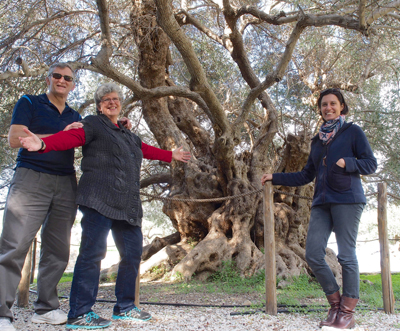The Amazing Science of Olive Oil

This story of a brilliant idea to make the olive the center of a liberal arts study, conceived by a professor from Turkey and taking root as a new Honors class at Keene State, actually starts at Amherst College, in Massachusetts. That’s where KSC Chemistry Professor Richard Blatchly’s wife, Patricia O’Hara (the Amanda and Lisa Cross Professor of Chemistry at Amherst) met Zeynep Delen Nircan, a visiting professor from Turkey. During her visit, Prof. Nircan became fascinated by the liberal arts approach to education, which is quite different from the Turkish approach.
“When you study chemistry in Turkey,” explained Dr. Blatchly, “that’s all you study. The curriculum doesn’t encourage including arts, or literature, or history. Your program focuses on required courses. The studies usually aren’t contextualized. You aren’t told, ‘here’s some chemistry, and here’s how it applies to society. …’ Students are just given an isolated problem to solve. From my perspective, they’re not serving their students as well as they could. Certainly they’re not preparing them for any type of career change.”
In 2010, Dr. Nircan invited Drs. Blatchly and O’Hara to participate in a teaching demonstrator institute, with the idea of bringing the liberal arts approach to Turkey.
The Chemistry of Olive Oil
“Dr. Nircan chose the olive as the center of her liberal arts focus, and we thought, ‘Well, chemically, it’s not going to be very interesting,’ and we were completely wrong—the chemistry of olive oil is fascinating,” Dr. Blatchly said. The husband and wife team took sabbaticals to go to the Mediterranean region to see the olive harvest, and then traveled to South Africa, Australia, and New Zealand to see the harvest there. Dr. Blatchly won a grant from the Whiting Foundation to help with the cost of his travel to South Africa.

Refining olive oil is a complex, exacting process, but one, like wine making, that also requires a degree of artistry from the overseer. “People running the processor have to understand the various stages of the process and know how to balance those stages,” Dr. Blatchly noted. “Balancing flow rates—how long to keep the olives in each stage of the process—is critical. The plant operators who made the best oil had a good sense of how to taste it to determine its quality, to see if it’s too bitter, or not bitter enough, etc. They are kind of doing chemistry, because taste is based on a chemical sensation. It’s not conscious chemistry, but rather an unconscious understanding. What we were trying to do was to listen to them so we could translate this unconscious sensing into a chemical understanding.”
For example, adding water during the process alters the flavor. Adding too much destroys the essential bitterness, which the processors knew, but they didn’t know chemically why that was so. “We were able to examine the molecules that give rise to the bitterness and understand how they would react to different stages of the process,” Dr. Blatchly explained.
Health Benefits
About 70% of good-quality oil is oleic acid. “It is not only the preferred fuel for your heart, but it also has a mild healing effect on the heart,” Dr. Blatchly said. “You would assume then, that it would also have a protective effect.” And the fat in olive oil is very easily digested and diets with significant amounts of olive oil in them, such as the Mediterranean diet, are not associated with weight gain.
Oleocanthal, the compound that produces the burning sensation in the back of your throat, is similar to ibuprofen in that it is a mild analgesic and also an anti-inflammatory, so it may have some effect on arthritis. Scientists are also beginning to study an aspect of olive oil that appears to influence Alzheimer’s disease. Research suggests that if you consume it regularly, it may be likely to keep Alzheimer’s at bay for a longer period of time.
The compounds that give the oil its characteristic bitterness are antioxidants (substances that may protect human cells from the damage that can occur from exposure to certain chemicals, smoking, pollution, etc.). But unlike vitamin E, which only goes into fat portions of the body, or vitamin C, which only goes into the water portions, olive oil’s antioxidants can go anywhere in the body, so they have a more broad-reaching effect.
Olive oil is a great source of energy. Though any kind of fat is energy dense, olive oil has an excellent fatty-acid profile. “The premium fatty acids are the mono-unsaturated fatty acids, and I’d call oleic the king of the mono-unsaturateds,” Dr. Blatchly said.
An Honors Class is Born
As the team studied the chemistry of olive oil, they also became immersed in the other aspects of its production: history, processing, distribution, weather and climate, art, literature, health, biology, agriculture, etc. “It’s the perfect liberal arts focus,” noted Dr. Blatchly.
As a result, Dr. Blatchly has developed an Honors course for nonscientists, “The Science of Olive Oil,” designed to study the history, art, and cultural aspects of the olive; explore the production of the oil and its chemical components and their biological impact; and critically analyze the research on the health effects of this product.
“Because many of the chemicals in olive oil can be sensed directly (smells, tastes, colors), it offers a wonderful platform to engage students in learning the chemistry behind these sensations,” Dr. Blatchly explained.
If you’d like to delve deeper into Drs. Blatchly and O’Hara’s study of the olive, check out their blog, World Olive Press.





